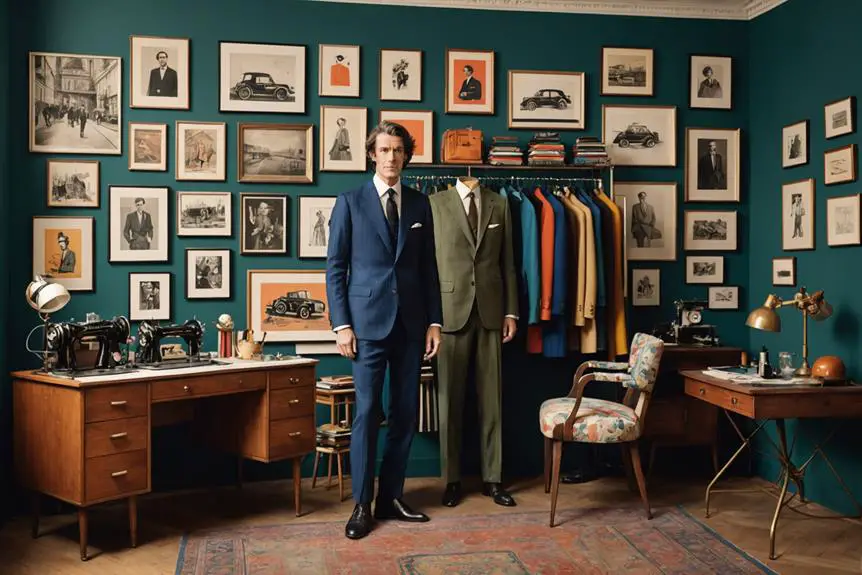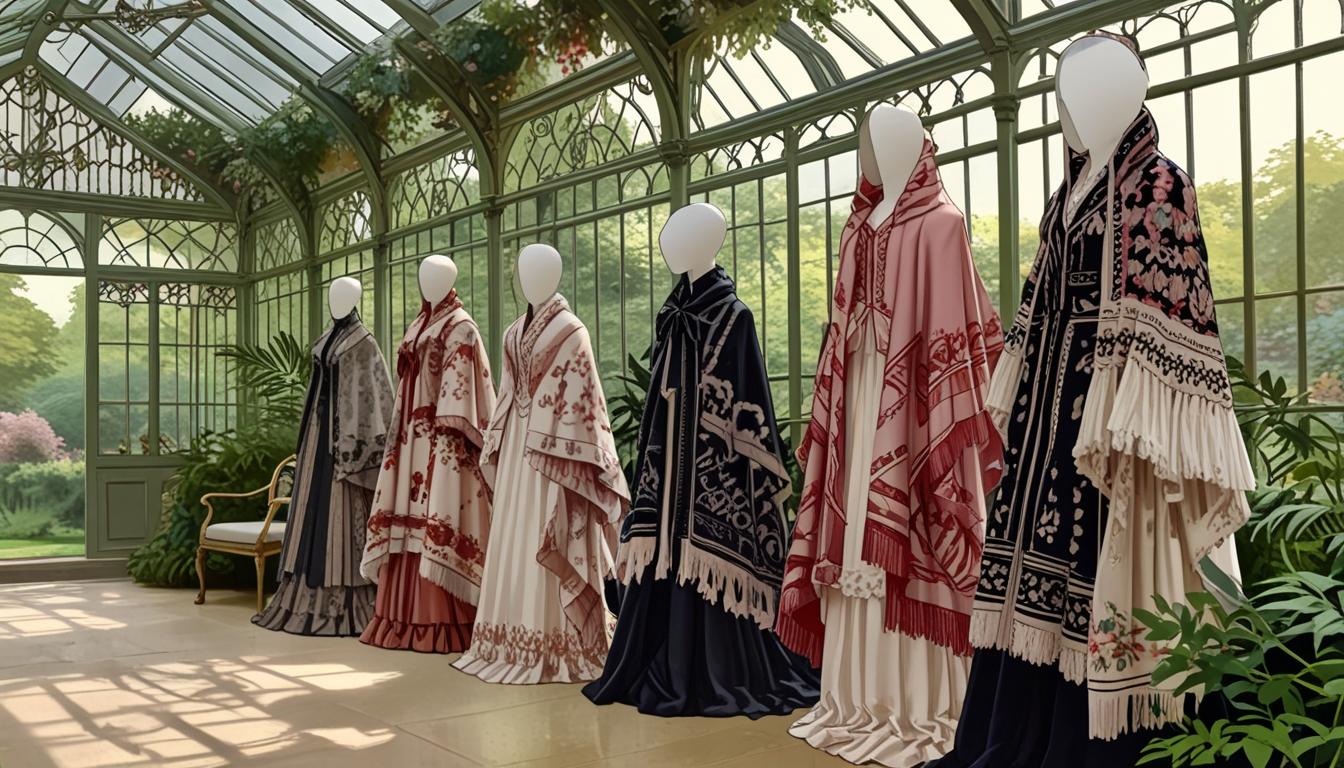Paul Smith began its journey in Beeston, Nottinghamshire, initially inspired by a passion for cycling, which was unexpectedly curtailed by an accident. This pivotal moment led to a shift towards fashion, with the opening of its first shop in 1970 after honing tailoring skills. The brand's debut menswear collection in Paris in 1976 marked a significant milestone, propelling it to prominence with iconic designs that feature the vibrant Signature Stripe. Expanding into womenswear and children's clothing, Paul Smith has garnered numerous accolades, including a knighthood in 2000. The brand is renowned for its ability to merge creativity with collaboration, showcasing a distinctive blend of fashion and lifestyle. There's a wealth of history and influence to explore regarding its lasting impact and unique design philosophy.
Early Life and Background

Paul Smith's journey began in Beeston, Nottinghamshire, where he was born on July 5, 1946, as the youngest of three children in a modest family. Initially, you might think his path would lead him to a career in professional cycling, given his early ambition. However, a serious cycling accident at age 17 changed everything, confining him to a hospital for six months. It was during this time that you'd notice his interest shifted toward art and fashion, laying the groundwork for his future.
After leaving school at just 15, without qualifications, Paul found himself working as an errand boy in a Nottingham clothing warehouse. This experience ignited his passion for fashion, prompting him to enroll in evening classes in tailoring. Here, he acquired essential skills in cloth cutting and design, eventually leading him to join the esteemed Lincroft Kilgour on Savile Row.
In 1970, Paul Smith opened his first shop, Paul Smith Vêtements Pour Homme, in a tiny 3 square meter space in Nottingham. This modest beginning marked the start of a remarkable fashion career, characterized by innovation and an unwavering commitment to quality.
Career Milestones and Achievements
How did a small shop in Nottingham evolve into a globally recognized fashion empire? Paul Smith's journey began in 1970 with his first shop, Paul Smith Vêtements Pour Homme, but it was his innovative approach that set him apart. His first menswear collection showcased in Paris in 1976 marked a pivotal moment, gaining international acclaim for blending casual and semi-formal styles.
Key milestones in his career include:
- Opening his flagship store in Covent Garden, London, in 1979, the first brand to grace Floral Street.
- Launching a womenswear collection in 1993, expanding his influence beyond menswear.
- Introducing Paul Smith Junior in 1990, diversifying into children's clothing.
- Earning recognition as Designer of the Year at the GQ Men of the Year Awards for four consecutive years.
- Being knighted in 2000 for his significant contributions to British fashion.
These achievements not only solidified Paul Smith's status as a designer but also showcased his ability to innovate within the industry, ultimately leading to the iconic status of his brand, particularly known for its Signature Stripe.
Signature Design Elements

In the world of fashion, certain design elements become instantly recognizable, and the Paul Smith Signature Stripe stands out as a prime example. This hallmark of the brand symbolizes its identity and creative ethos, continuously evolving to reflect modernity while rooted in tradition. You'll notice that the iconic multicoloured stripes embody the eclectic and playful nature of Paul Smith's designs, making them a staple across various collections.
Each piece showcases a commitment to craftsmanship, where meticulous attention to detail guarantees these signature elements are seamlessly integrated. Whether it's clothing or accessories, the Signature Stripe maintains a recognizable brand aesthetic that resonates with both loyal customers and new admirers alike. This design philosophy emphasizes a harmonious blend of tradition and modernity, allowing the stripe to adapt without losing its essence.
As you explore the Paul Smith collection, you'll see how these design elements not only create visual appeal but also tell a story about the brand's evolution. The Signature Stripe serves as a bridge between past and present, encapsulating the spirit of innovation that defines Paul Smith and reinforces its position in the ever-changing landscape of fashion.
Collaborations and Partnerships
Collaborations and partnerships have been instrumental in shaping Paul Smith's brand identity and expanding its creative horizons. As a fashion designer committed to contemporary design, Paul Smith has engaged in various notable projects that reflect his unique design aesthetic while pushing boundaries.
Consider some of these significant collaborations:
- Limited Edition Mini Car (1997): A striking union of fashion and automotive design, with only 1,800 units produced.
- Cappellini Homeware Collection (2002): This partnership showcased his design aesthetic in interior spaces, elevating everyday objects.
- Maharam Textiles (2003): An ongoing collaboration emphasizing innovative textile designs that blend functionality with creativity.
- Triumph Bonneville T100 Motorcycle (2005): A stylish restyling that merged the worlds of fashion and motorcycles, enchanting enthusiasts.
- Sustainable Mini Electric Project (2021): Reflecting a commitment to contemporary design and environmental responsibility, this project emphasizes sustainability.
These collaborations not only highlight Paul Smith's versatility but also illustrate how he continuously adapts to changing aesthetics and consumer values, ensuring his relevance in today's dynamic market.
Recognition and Cultural Impact

Paul Smith's collaborations have not only expanded his brand's creative reach but also set the stage for the recognition and cultural impact he's achieved within the fashion world. Over the years, you've seen him receive numerous accolades, including the coveted Designer of the Year title at the GQ Men of the Year Awards for four consecutive years. His Outstanding Achievement Award at the British Fashion Awards in 2011 further solidified his status.
Knighted in 2000 and appointed Commander of the Order of the British Empire in 1994, his contributions to fashion are undeniable. His brand is distinguished by vibrant colors and playful patterns that authentically reflect British culture, influencing contemporary fashion trends. You might've noticed the iconic pink wall at his flagship store, which has become a selfie hotspot, enhancing the brand's cultural significance in the digital age.
Moreover, his impact on cycling culture is significant; his lifelong passion for the sport is evident through his collaborations with professional cyclists, merging style with athleticism. Paul Smith's legacy is a proof of how creativity can transcend traditional boundaries, shaping both the fashion landscape and cultural narratives.
Frequently Asked Questions
What Is Paul Smith Best Known For?
You'll find Paul Smith best known for its vibrant multicolored stripe designs, which embody a unique blend of traditional tailoring and eclectic styles, reflecting a philosophy that embraces inspiration from everyday life and culture.
What Inspired Paul Smith?
You'll find Paul Smith inspired by everything around you—from art and music to everyday experiences. His vibrant designs reflect an eclectic mix of influences, showcasing a unique narrative that resonates with a diverse audience.
What Was Paul Smith's Passion?
Paul Smith's passion was cycling. You can see how this enthusiasm shaped his creative journey, driving him to blend art and fashion. His designs often reflect the vibrancy and energy he found in cycling culture.
Why Was Paul Smith Knighted?
You'll find Paul Smith was knighted for his remarkable contributions to British fashion, showcasing innovative design and promoting craftsmanship. This honor reflects his influence in the industry and solidifies his status as a leading designer.




